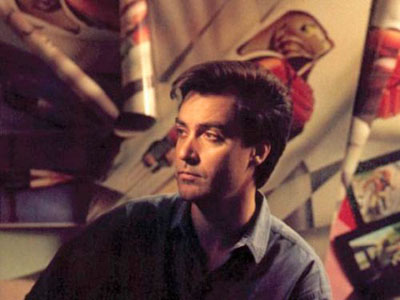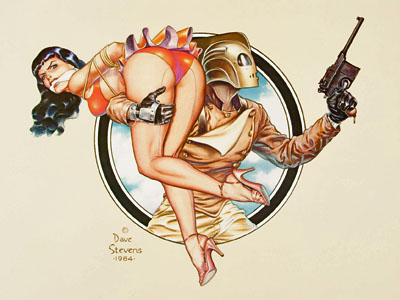
Illustrator Dave Stevens, best known for his "good girl" art and The Rocketeer, died yesterday following a long, wrenching battle with Leukemia. Dave was born July 29, 1955 in Lynwood, California. He was raised in Portland, Oregon, then his family relocated to San Diego, where he attended San Diego City College and became involved in the early days of the San Diego Comic Book Convention, now known as the Comic-Con International. His skills as an artist were instantly evident to all, and he was encouraged by darn near every professional artist who attended the early cons, but especially by Jack Kirby and Russ Manning. In 1975, when Manning began editing a line of Tarzan comic books to be published in Europe, Dave got his first professional assignment, working on those comics and also assisting Russ with the Tarzan newspaper strip. Soon after, he worked on a few projects for Marvel (including the Star Wars comic book) and a number of underground comics. Later, he also worked with Russ on the Star Wars newspaper strip.
In 1977, Dave went to work for Hanna-Barbera where he drew storyboards and layouts, many of them for the Super Friends and Godzilla cartoon shows and bonded with veteran artist Doug Wildey, who produced the latter. Wildey and Stevens became close friends and in 1982, when Dave created his popular character, The Rocketeer, he modelled the character's sidekick, Peevy, on photos of Doug. Dave himself was Cliff Secord, who donned the mask of The Rocketeer, and other friends appeared in other guises.

The Rocketeer made Dave's reputation and also spawned a resurgence of interest in fifties' figure model Bettie Page, whose likeness Dave used for the strip's heroine. But the strip was not profitable for Dave, who was among the least prolific talents to ever attempt comic books. It wasn't so much that he was slow, as his friends joked, but that he was almost obsessively meticulous, doing days of study and sketching to create one panel, and doing many of them over and over. Even then, he was usually dissatisfied with what he produced and fiercely critical of the reproduction. Friends occasionally pitched in to help with the coloring but some begged off because they knew it was humanly impossible for anyone, including Dave himself, to produce coloring that he'd like. Eventually, he sold most of the rights to Disney for a Rocketeer movie that was produced in 1991. Dave served as a co-producer of the film and did a brief cameo, but the endeavor was not as lucrative for him as he'd hoped, and it pretty much ended Dave's interest in continuing the character.
Most of what Dave did after that fell into the general category of "glamour art," including portfolios and private commissions. Many of these were illustrations of Bettie Page who, though once thought deceased, turned out to be alive and living not all that far from Dave. They met and Dave became her friend and, though he was not wealthy, benefactor. Deciding that too many others had callously exploited her likeness, Dave voluntarily aided Ms. Page financially and even took to helping her in neighborly ways. One time, he told me — and without the slightest hint of resentment — "It's amazing. After years of fantasizing about this woman, I'm now driving her to cash her Social Security checks."
Dave was truly one of the nicest people I have ever met in my life…and was certainly among the most gifted. Our first encounter was at Jack Kirby's house around 1970 when he came to visit and show Jack some of his work. As I said, Kirby was very encouraging and he urged Dave not to try and draw like anyone else but to follow his own passions. This was advice Dave took to heart, which probably explains why he took so long with every drawing. They were rarely just jobs to Dave. Most of the time, what emerged from his drawing board or easel was a deeply personal effort. He was truly in love with every beautiful woman he drew, at least insofar as the paper versions were concerned. (Dave was married once…for six months to the prolific movie actress, Brinke Stevens, and she retained his last name after they divorced.)
Dave's illness these last few years was a poorly-kept secret among his friends, but he insisted that it be kept quiet, and struggled to make occasional public appearances. We tried to get together for dinner every month or so but it wound up being more like every six months. The last time, he joked that it was lucky he had such a reputation for slow production. Now that he was unable to work for weeks at a time, no one noticed that his output had declined. His main efforts went towards an "Art of Dave Stevens" book he was struggling to assemble. Mostly though that evening, we talked about comics and comic artists. Dave was a fan in the very best sense.
I don't really know how to end this and maybe I don't want to…because it will mean another level of loss regarding one of my closest friends. As long as I can keep writing about him, I feel he's still with me in some manner. And the thought of losing a great guy like Dave Stevens is just too, too sad. He was truly loved and admired by all who knew him. I'll post information about a memorial service, if and when I hear about that kind of thing.